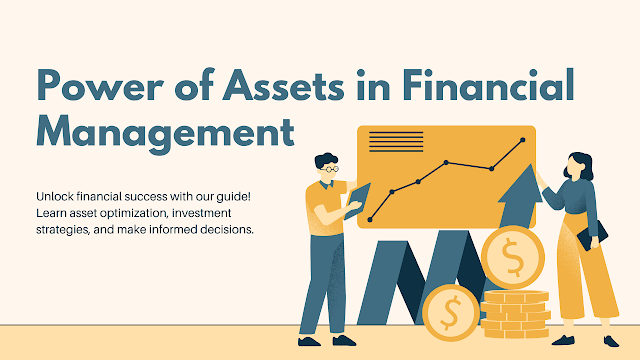Cautionary Note: I Am Not a Financial Expert, Do Your Own Research Too.
I. Introduction
When it comes to financial management, the significance of assets cannot be overstated. Assets serve as the backbone of a robust financial portfolio, providing the foundation for long-term success. In this guide, we delve into the world of asset optimization, unraveling the intricacies of different asset classes and exploring strategies to maximize returns.
II. Understanding Different Asset Classes
Definition and Classification
Assets come in various forms, each with its unique characteristics. Equities, fixed-income securities, real assets, and cash equivalents constitute the primary asset classes. Understanding the distinctions is crucial for effective financial planning.
Risk-Return Profiles
Delving into the risk-return profiles of each asset class unveils the dynamics that drive investment decisions. Equities may offer high returns but come with increased risk, while fixed-income securities provide stability at the expense of lower returns.
III. Importance of Asset Allocation
Role in Risk Management
Asset allocation plays a pivotal role in managing risks and achieving portfolio diversification. Balancing different asset classes based on financial goals is essential to create a resilient investment strategy.
Strategies for Effective Asset Allocation
Navigating through effective asset allocation strategies tailored to individual financial goals ensures a well-rounded approach to investment. It's not just about spreading risk but optimizing the mix for optimal returns.
IV. Navigating Investment Strategies
Long-Term vs. Short-Term Strategies
Deciding between long-term and short-term investment strategies requires a nuanced understanding of individual preferences and financial objectives. Balancing high-risk and low-risk investments is the key to a successful investment journey.
Identifying Trends and Opportunities
Being attuned to market trends and identifying opportunities is a skill that distinguishes successful investors. This section explores strategies to stay ahead in the dynamic world of investments.
V. Maximizing Returns through Asset Optimization
Techniques for Optimization
Optimizing asset portfolios involves a blend of strategic decision-making and adapting to market trends. Techniques ranging from rebalancing to smart investment choices are explored in this section.
Impact of Market Trends
Understanding how market trends influence asset optimization is crucial for making informed decisions. Real-world case studies illustrate how successful investors have navigated through changing market dynamics.
VI. Assessing the Risks Associated with Different Assets
Analyzing Risk Factors
A detailed analysis of the risk factors associated with equities, bonds, and other assets provides insights into potential challenges. Understanding the risks is the first step towards effective risk management.
Mitigation Strategies
Mitigating risks involves implementing strategies to minimize potential downsides. This section offers practical approaches to safeguarding investments against market uncertainties.
VII. Realizing the Potential of Real Assets
Benefits of Real Assets
Real assets, including real estate and commodities, offer unique advantages in a diversified portfolio. Exploring these benefits and understanding how they contribute to overall financial health is essential.
Tangible Investments
This section delves into tangible investments, highlighting their role in balancing a diversified portfolio. Real-world examples showcase the value of including real assets in long-term financial planning.
VIII. The Art of Financial Decision-Making
Factors Influencing Decisions
Financial decision-making is an art that involves considering various factors. Balancing short-term needs with long-term goals is a delicate act that influences the trajectory of one's financial journey.
Aligning Decisions with Goals
This section emphasizes aligning financial decisions with long-term objectives, ensuring that every choice contributes to the overall financial well-being.
IX. Case Studies: Successful Asset Management Stories
Examining Real-Life Success
Real-life success stories in asset management offer valuable insights. Analyzing these cases provides key takeaways and lessons for readers looking to replicate success in their own financial endeavors.
X. Conclusion
In conclusion, this comprehensive guide demystifies the world of assets in financial management. From understanding different asset classes to mastering the art of financial decision-making, readers now possess the knowledge to optimize their portfolios for sustained success. Embark on your journey toward financial prosperity armed with the insights gained from this guide. Start making informed decisions today!
Frequently Asked Questions(FAQ's):
1. How do I determine the right asset allocation for my financial goals?
Assess your risk tolerance and financial objectives. Guidelines and tools in the blog can help.
2. What are the common risks associated with equities, and how can they be mitigated?
Equity risks include volatility and economic downturns. The blog suggests strategies to minimize risks and maximize returns.
3. Is it advisable to focus on long-term investments, and why?
Yes, for wealth building. The blog provides examples of successful long-term strategies, emphasizing patience and strategic planning.
4. How can real assets contribute to a diversified portfolio?
Real assets like real estate and commodities add diversity. The blog explains the benefits and provides guidance on balancing with other investments.






0 Comments